Immerse yourself in tales of Persian kings in the Bible, where history meets faith, shaping destinies and divine narratives.
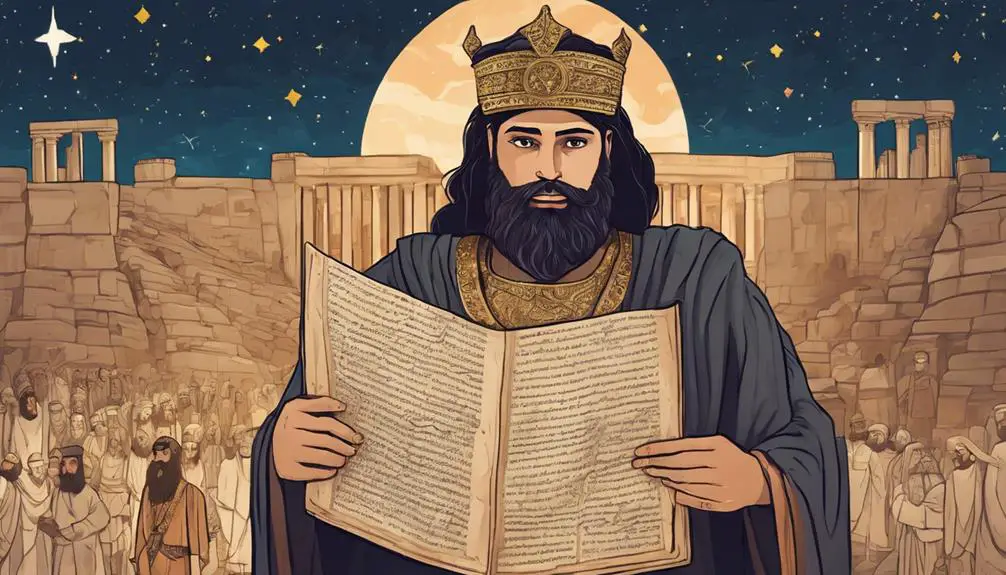
Persian Kings in the Bible
Navigating through the tales of Persian kings in the Bible is like embarking on a journey through a landscape rich with historical and spiritual landmarks. You'll discover how Cyrus the Great's edict not only reshaped the Jewish exile but also left an indelible mark on religious freedom.
With Darius I, the narrative takes you through the reconstruction of the Temple, a pivotal moment for Jewish identity. Meanwhile, Xerxes I and Artaxerxes I play crucial roles in the survival and rebuilding of Jerusalem, with stories that intertwine with Biblical prophets and figures.
Yet, it's Ahasuerus and Esther's tale that often captures the imagination, weaving themes of courage, faith, and providence. As you explore these intersections of history and faith, you'll find yourself at the crossroads of ancient politics, religion, and the enduring human spirit, eager to uncover more about how these rulers shaped and were shaped by the Biblical narrative.
Key Takeaways
- Persian kings facilitated the restoration and rebuilding of Jerusalem and its Temple.
- The Persian Empire's tolerance and support significantly influenced Jewish history and biblical events.
- Figures like Esther and Nehemiah highlight the impact of individual agency within the Persian court on Jewish communities.
- The portrayal of Persian rulers in the Bible reflects their role as instruments of God's will in Jewish narrative.
Cyrus the Great's Edict
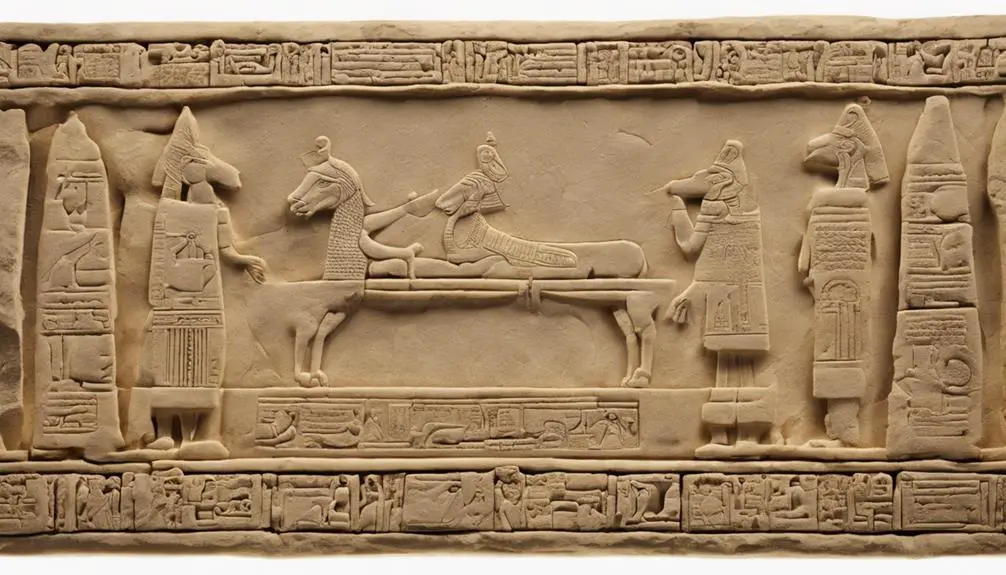
Cyrus the Great's edict, a pivotal decree in Biblical history, explicitly allowed the Jewish exiles in Babylon to return to Jerusalem and rebuild their temple. This act, recorded in the Cyrus Cylinder and echoed in biblical texts, marks a significant moment in the intertwining of Persian policy with the fate of the Jewish people. The Cyrus Cylinder, a clay artifact, is often cited as the first charter of human rights, illustrating a policy of religious freedom and repatriation.
You'll find that this decree wasn't an isolated incident but part of a broader Persian policy under Cyrus the Great, aimed at governing a vast and diverse empire through a strategy of tolerance and local autonomy. This approach was revolutionary, setting a precedent for the administration of a multi-ethnic state. By allowing the Jews to return and rebuild, Cyrus not only secured loyalty but also fostered a sense of goodwill among his subjects.
Analyzing the edict's implications, it's clear that it was a masterstroke in Persian imperial strategy, blending pragmatism with a visionary approach to empire-building. This policy of tolerance and support for local traditions and religions under Cyrus set the stage for a relatively stable and prosperous period under Persian rule.
Darius I and the Temple
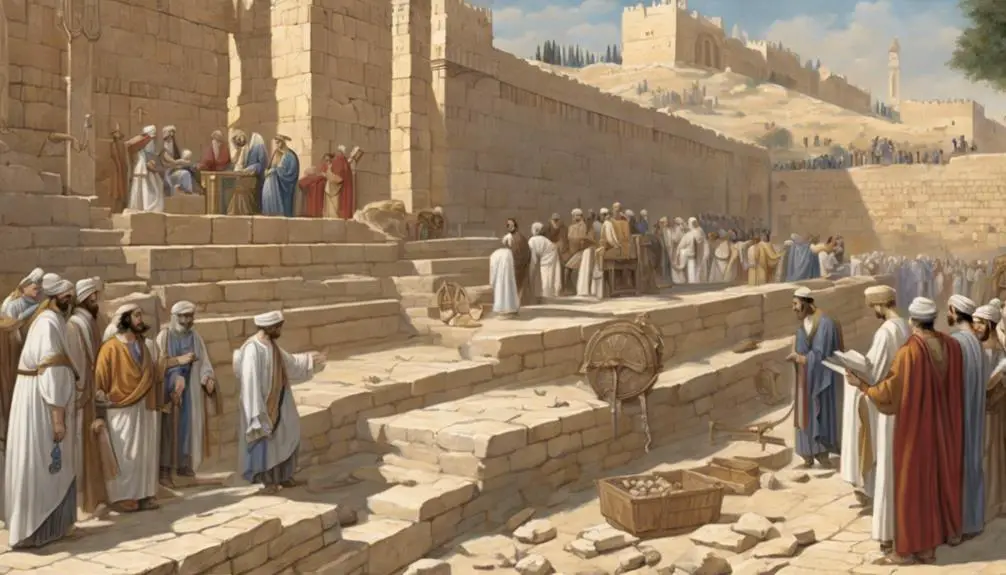
Following Cyrus the Great's policy of tolerance, Darius I played a pivotal role in the continuation and completion of the Jerusalem Temple project, underscoring the enduring Persian influence on Jewish religious infrastructure. His reign marked a significant period where royal support for religious inclusivity directly impacted the Jewish community, enabling them to rebuild their central place of worship.
Key aspects of Darius I's involvement include:
- Royal opposition: Despite facing significant opposition from local governors questioning the authority and intentions behind the Jewish temple construction, Darius reaffirmed Cyrus's decree, ensuring the continuation of the project.
- Architectural contributions: Darius's administration provided materials and resources, highlighting the practical support for the temple's reconstruction. This move not only facilitated the physical building process but also symbolized the Persian empire's commitment to fostering religious diversity.
- Administrative support: Beyond mere tolerance, the Persian empire under Darius I actively engaged in facilitating the temple's completion, demonstrating a nuanced approach to governance that recognized the importance of religion in maintaining social order and cohesion.
Darius I's actions reflect a sophisticated understanding of the role of religion within the empire, emphasizing a pragmatic approach to governance that sought to integrate diverse cultural and religious practices.
Xerxes I in Biblical Context
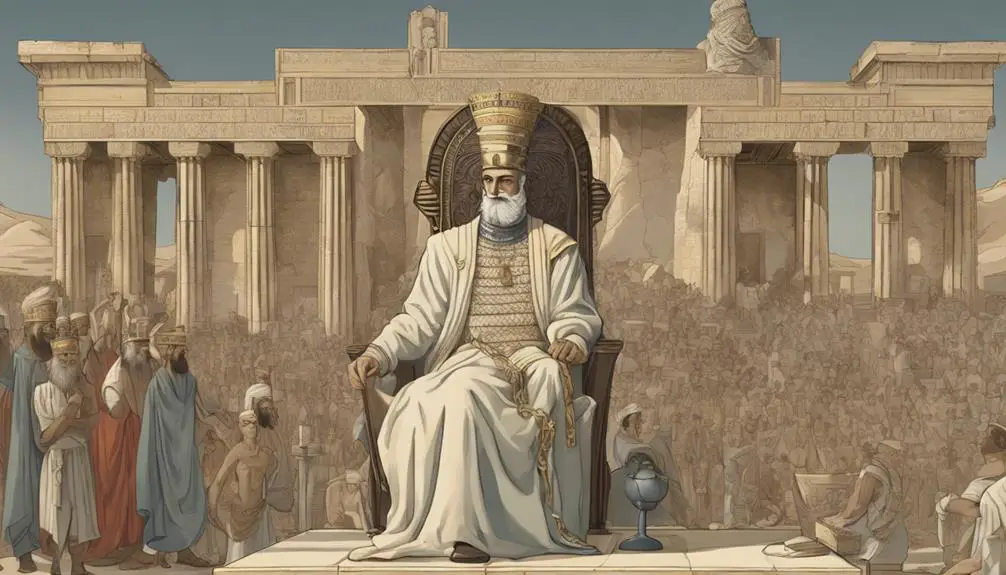
Building upon the foundation of religious tolerance established by his predecessors, Xerxes I's reign in the biblical context presents a complex interplay between Persian authority and Jewish religious life. You'll find that his era was marked not only by significant administrative decisions but also by notable military campaigns, which had indirect impacts on the Jewish population under Persian rule.
Aspect |
Description |
Impact on Jewish Life |
|---|---|---|
Governance |
Consolidation of Persian authority |
Stability and Autonomy |
Religious Policy |
Continuation of tolerant practices |
Flourishing of Jewish Practices |
Military Campaigns |
Expansionist ambitions and battle strategies |
Indirect Effects on Security and Prosperity |
Xerxes' reign was characterized by a dual approach of maintaining the empire's vast territories through strategic governance and embarking on military campaigns, notably against Greek city-states, which showcased his battle strategies. This era, thus, was a time of relative peace and prosperity for the Jewish communities within the Persian Empire, allowing them to continue religious practices with a degree of autonomy. However, the military ambitions of Xerxes, while demonstrating the empire's strength, also led to periods of uncertainty that indirectly affected the security and economic stability of its subjects, including the Jewish population.
Artaxerxes I: Rebuilder of Jerusalem
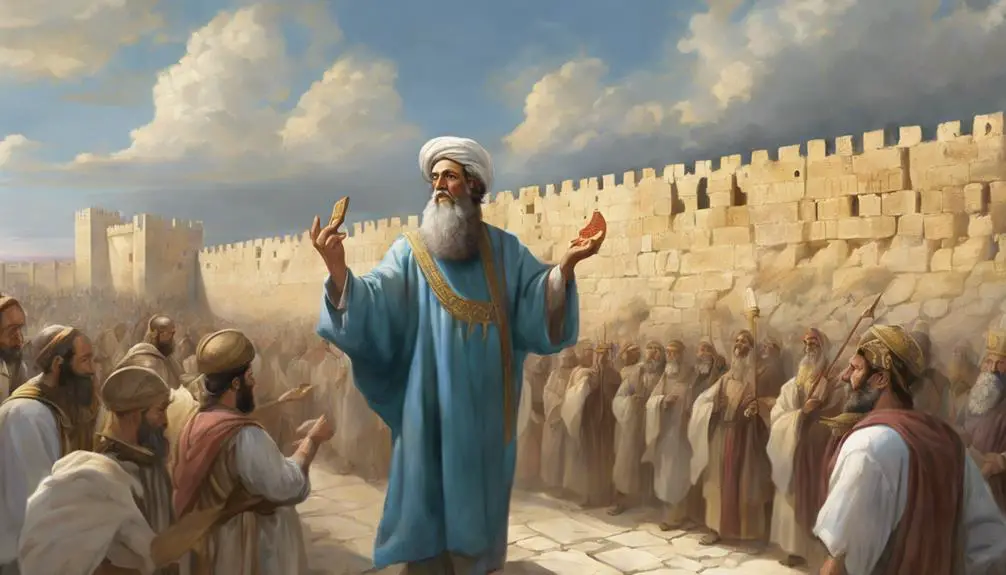
Artaxerxes I, stepping into the annals of history, significantly contributed to the Jewish narrative by initiating the reconstruction of Jerusalem's walls and temple. His reign marked a pivotal moment in the relationship between the Persian Empire and its Jewish subjects, driven by a blend of economic policies and diplomatic relationships. Artaxerxes' actions weren't merely benevolent but strategic, aiming to stabilize the region and secure its prosperity under Persian rule.
Consider the following aspects of his reign:
- Economic Policies: Artaxerxes I implemented reforms that boosted the economy of the empire, indirectly facilitating the resources needed for the reconstruction efforts in Jerusalem. His policies ensured that the rebuilding didn't strain the empire's finances, demonstrating a shrewd understanding of economic management.
- Diplomatic Relationships: By supporting the Jews in their endeavor to rebuild Jerusalem, Artaxerxes I fostered a loyal buffer state that could serve as a deterrent against rebellions and external threats. This move showcased his diplomatic acumen.
- Strategic Rebuilding: The reconstruction of Jerusalem's walls and temple served both spiritual and strategic purposes, symbolizing a restoration of Jewish identity while fortifying a key location in the Persian Empire.
Artaxerxes I's tenure as king underscores the intricate interplay between economic strategies and diplomatic relations in ancient statecraft, highlighting his significant role in the historical and biblical narrative of the Jewish people.
Ahasuerus and Esther's Tale
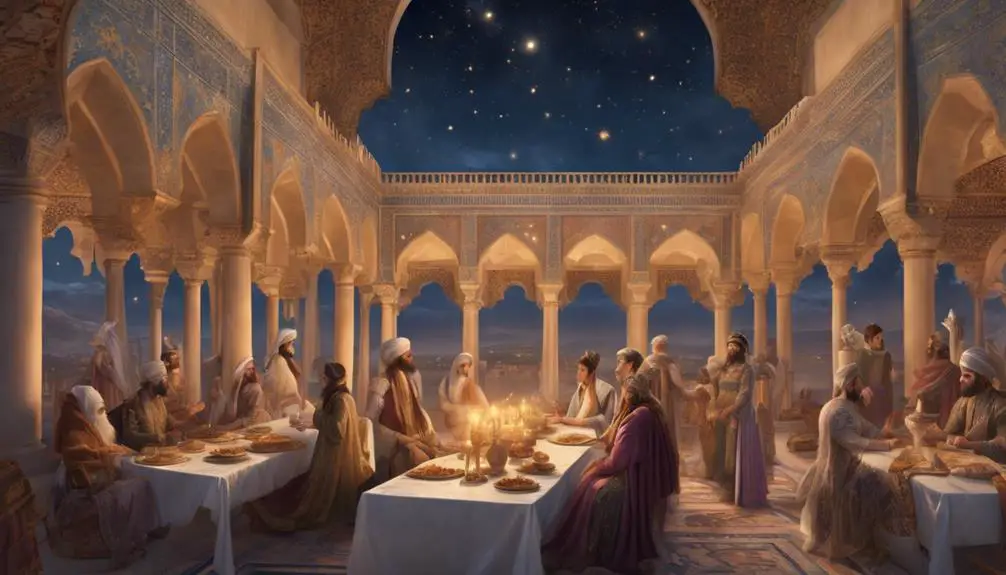
Diving into the heart of biblical narratives, the tale of Ahasuerus and Esther unfolds a complex story of intrigue, identity, and intervention within the Persian Empire. At its core, this narrative revolves around a royal banquet, serving as the catalyst for a series of events that expose an identity crisis and a plot of genocide against the Jewish people living in Persia.
You observe that the royal banquet isn't merely a backdrop but a pivotal moment where Queen Vashti's refusal to appear leads to her dismissal, setting the stage for Esther's ascension to queen. This isn't just a tale of power shifts; it's an intricate examination of identity, as Esther conceals her Jewish heritage at her cousin Mordecai's behest. The identity crisis reaches its peak when Haman, the king's advisor, schemes to annihilate the Jews, unaware of Esther's true identity.
Your analysis reveals that Esther's tale is one of strategic intervention. She navigates the perilous waters of the Persian court, leveraging her position and her identity to secure her people's survival. This narrative, rich in cultural and political implications, demonstrates the complexity of identity and the power of individual agency within the sprawling Persian Empire.
Frequently Asked Questions
How Did the Persian Kings' Policies Towards Jews Compare With Those of Other Contemporary Empires?
You're looking at how Persian kings' approaches to Jews differed from other empires of their time, especially in terms of trade policies and military strategies.
Unlike some, the Persians often adopted more tolerant policies, allowing freedoms that facilitated trade and could indirectly benefit their military strategies by ensuring loyalty without resorting to force.
This contrasted with empires that might suppress or exploit conquered peoples, undermining potential economic and strategic advantages.
What Archaeological Evidence Exists to Support the Historical Accounts of Persian Kings Mentioned in the Bible?
You're diving into the evidence backing historical figures, focusing on artifacts like the Cyrus Cylinder and Darius's inscriptions.
The Cyrus Cylinder's significance lies in its decree, paralleling biblical accounts, while Darius's inscriptions offer a deep analysis of governance, echoing narratives of tolerance.
These pieces not only confirm historical events but also provide a broader understanding of the era, bridging gaps between archaeological findings and ancient texts.
How Do Jewish Traditions and Interpretations Outside of the Bible View the Persian Kings, Especially in Relation to Their Roles in Jewish History?
You're diving into how Jewish traditions and interpretations, aside from the Bible, view Persian kings. Interestingly, 90% of the Cyrus Cylinder inscriptions highlight Cyrus's policies on religious freedom, resonating deeply with Jewish perspectives on his role in their history.
These traditions also analyze the Achaemenid architecture's influence, appreciating its contribution to the period's cultural exchange. Through scholarly eyes, you'll find these interpretations offer a nuanced understanding of Persian and Jewish historical interconnections.
What Influence Did Persian Rule Have on the Religious Practices and Beliefs of the Jewish People During and After the Persian Empire's Dominion?
You're exploring how Persian rule reshaped Jewish religious practices and beliefs. During and after their dominion, the Zoroastrian influence and the Cyrus Cylinder played pivotal roles. These elements likely introduced new theological perspectives and practices among the Jewish people.
This period marked a significant point where external governance directly impacted the development of religious identity, possibly blending or reinforcing existing traditions with novel ideas from the Persian cultural and religious milieu.
How Have Modern Historians and Scholars Reconciled Discrepancies Between Biblical Accounts of Persian Kings and Historical Records From Other Sources?
Diving into history's puzzle, you'll find that modern scholars use textual analysis to bridge gaps between conflicting accounts. They meticulously compare biblical narratives with archaeological findings and other ancient texts.
This approach, known as chronological synchronization, helps them piece together a more coherent timeline. By doing so, they're not just reconciling stories; they're weaving a tapestry that honors both historical accuracy and the depth of biblical narratives.
Conclusion
In conclusion, the presence of Persian potentates like Cyrus the Great, Darius I, Xerxes I, and Artaxerxes I in Biblical narratives not only highlights historical intersections but also illustrates the intricate interplay between divine decrees and dynastic deeds.
These rulers' roles, ranging from releasing captives to rebuilding sacred spaces, underscore a unique unity between faith and governance.
Such stories, steeped in strategic significance and spiritual symbolism, offer a rich tapestry for theological and historical analysis, painting a panoramic picture of Persian influence on pivotal Biblical passages.

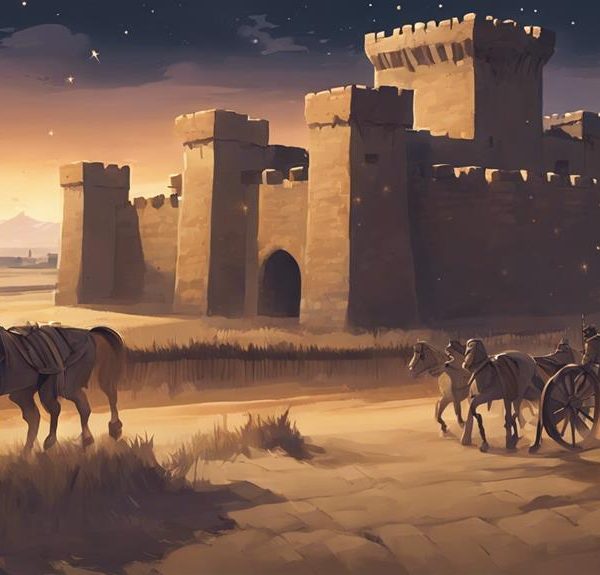
Sign up